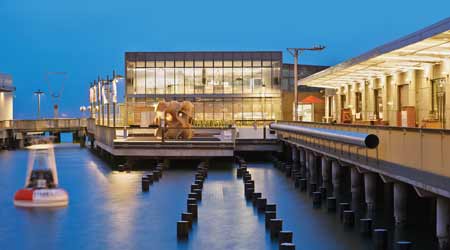 The Exploratorium in San Francisco, built in 1913, achieved zero net energy consumption through deep energy retrofits combined with onsite renewable energy produced by a rooftop photovoltaic array that generates 1.4 megawatts of electricity.Bruce Damonte
The Exploratorium in San Francisco, built in 1913, achieved zero net energy consumption through deep energy retrofits combined with onsite renewable energy produced by a rooftop photovoltaic array that generates 1.4 megawatts of electricity.Bruce Damonte How To Use Renewable Energy To Achieve Zero Energy Existing Buildings
Onsite renewable energy generation and onsite energy storage are critical pieces of the zero energy building puzzle.
Once core, deep building efficiency is achieved, a renewable energy portfolio can be rolled into the building design which includes passive strategies such as natural light and ventilation, passive solar heating, atmospheric and ground-source heat pump technologies for HVAC and domestic hot water, onsite energy generation coupled with onsite energy storage, and advanced energy management; all are critical and interrelated. Since the goal is zero net energy averaged over a year, the building is still connected to grid; however, during periods of total grid peak energy consumption, the building’s power management system supplies energy to the grid rather than drawing power from it. (Currently the grid is experiencing growing pains, particularly due to the higher than predicted increase in photovoltaic installations nationally, which has created a second electrical peak demand period between 5 p.m. and 9 p.m., linked to the 10 minutes when the sun sets and photovoltaic generation drops to zero.) Onsite energy storage is a critical component to facilitate this electrical load balancing act.
The Exploratorium public learning laboratory in San Francisco, originally built in 1913, is an example of successfully achieving ZNE in a pre-existing building through deep energy retrofits combined with onsite renewable energy generation through a rooftop photovoltaic array. The Exploratorium is a 330,000-square-foot, wharf-side building on San Francisco’s historic waterfront with 175,000 square feet of conditioned space. Heating and cooling is provided by water source heat pumps which transfer heat to and from the San Francisco Bay at relatively constant temperature to the building. This is done through radiant heat floors (27 miles of plastic tubing across 82 heating zones) and a highly efficient HVAC system combined with ventilation provided by a separate dedicated outdoor air system (DOAS).
Daylighting is provided by clerestory windows and strategically placed skylights. The flat roof is lined with 78,712 square feet of photovoltaic panels which generate 1.4 megawatts of electricity. The building’s energy management system monitors thousands of data points including floor temperature, room temperature, and carbon dioxide levels, providing building management staff the feedback to track indoor climate trends that, over time, inform staff how to best manage the building’s environment. This also takes advantage of low energy prices during the night and fine-tunes energy consumption during the day. The total project cost was $133 million — $700 per square feet.
Although not a ZNE building, the Empire State Building retrofit is no less impressive. This deep retrofit included the remanufacturing of 6,514 windows onsite into super windows, cutting winter heat loss by at least two-thirds and summer heat gain by half. The original budget for energy-related projects (projects that may somehow affect energy use) was approximately $93 million. This energy budget included a project to replace the chiller plant to increase cooling capacity, which would have required tearing up Fifth Avenue to bring the new chillers into the building. However, by first implementing strategies that reduced the building’s cooling demand, it was possible to reduce the cooling capacity by 1,600 tons, allowing the chillers to be retrofit rather than replaced for a capital savings of $17.3 million.
David Park is director of air quality at Alta Environmental in Long Beach, Calif., a full-service environmental consulting firm. Park specializes in technical analysis to inform corporate strategic policy decisions regarding environmental issues.
Email comments and questions to edward.sullivan@tradepress.com.
Related Topics:















